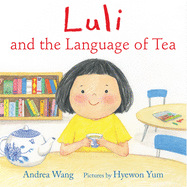LULI AND THE LANGUAGE OF TEA
Author: Andrea Wang
Illustrator: Hyewon Yum
Review Issue Date: June 15, 2022
Online Publish Date: May 25, 2022
Publisher:Neal Porter/Holiday House
Pages: 40
Price ( Hardcover ): $18.99
Publication Date: May 17, 2022
ISBN ( Hardcover ): 978-0-8234-4614-8
Section: Children's
A group of children find commonality and togetherness through tea.
While a diverse group of grown-ups attend English as a second language class, young ones attend free child care next door. Like the adults, no one speaks English, and “all around the room, children played alone.” However, Luli, who is cued as Chinese, has a plan to get everyone to play together. Today, she’s brought a full tea set. When the table is set and Luli calls out in Chinese, “Chá,” “all around the room, heads popped up.” In a series of panels, children chime back in Russian, Hindi, Turkish, Persian, Arabic, Spanish, German, Swahili, and Portuguese. The word for tea sounds quite similar across languages, and soon enough each child grabs a seat at the table to share a warm cup of tea. Shy smiles lead to full hearts. Yum’s colored-pencil illustrations work alongside Wang’s simple, rhythmic text to highlight the concepts of uniqueness and similarity. Gentle, repeated refrains like “all around the room/table” and measured moments of tea cups passed back and forth create beats of unity and circularity. Languages are presented in their script with romanization/transliteration for pronunciation. Perspectives and layouts vary for a dynamic read and give space to each child and their individuality. Endpapers showcase teacup designs from the 10 countries highlighted; in an author’s note, Wang describes the childhood experience that inspired the book. (This book was reviewed digitally.)
A warming and gentle celebration of connection. (information on the countries depicted) (Picture book. 3-7)




